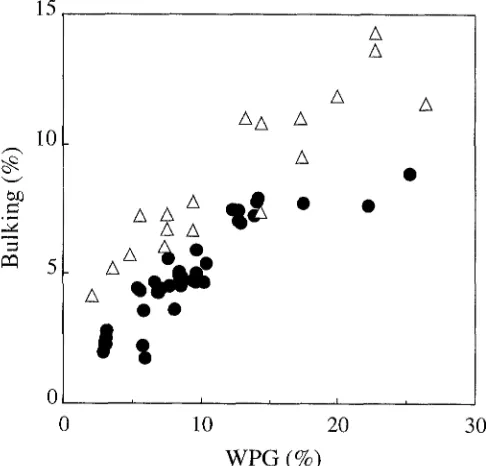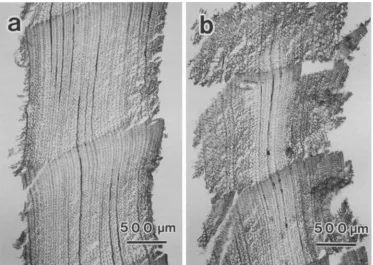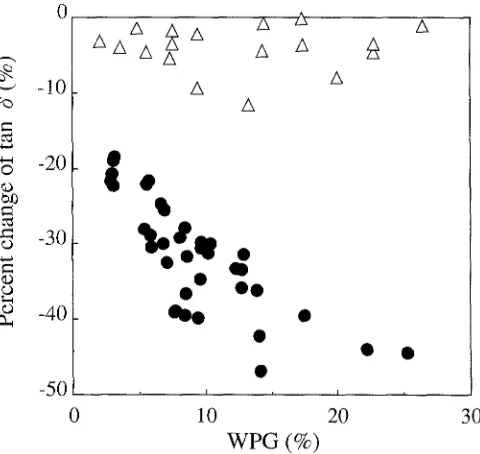J Wood Sci (1999) 45:470-474 © The Japan Wood Research Society 1999
Masahiro Matsunaga • Kazuya Minato Fumiaki Nakatsubo
Vibrational property changes of spruce wood by impregnation with water-
soluble extractives of pernambuco
(Guilandina echinata
Spreng.)
Received: January 28, 1999 / Accepted: March 24, 1999
Abstract Sitka spruce
(Picea sitchensis
Carr.) was treated with water-soluble extractive components of pernambuco(Guilandina echinata
Spreng. synCaesalpinia echinata
Lam.) by two methods: impregnation under evacuation us- ing an aspirator and repetitive surface application using a brush. The influence of these treatments on the vibrational properties were examined. The loss tangent (tan6) of the impregnated specimen decreased, up to nearly a half of its original value, with increasing weight gain. It is suggested that the decrease in tan 6 results from impregnation of the extractive components into the amorphous region of cell walls, forming secondary bonds between matrix substances. The surface application of the extractive components, on the other hand, hardly brought about the desirable change in vibrational properties.Key words Pernambuco • Vibrational property • Extrac- tives • Impregnation • Musical instrument
Introduction
Pernambuco
( Guilandina echinata
Spreng. synCaesalpinia
echinata
Lain.) is the most suitable material for the violin bow. In previous studies 1'2 we found that the loss tangent (rand) of pernambuco was exceptionally low among many wood species examined and proposed that low tan6 is a necessary factor for bow material. We also reported that low tan6 is attributed to the large amount of extractiveM. Matsunaga. K. Minato ([]) - F. Nakatsubo
Graduate School of Agriculture, Kyoto University, Kyoto 606-8502, Japan
Tel. +81-75-753-6257; Fax +81-75-753-6300 e-mail: minato@kais.kyoto-u.ac.jp
Part of this work was presented at the 47th annual meeting of the Japan Wood Research Society, Kochi, April 1997, and the 48th annual meet- ing of the Japan Wood Research Society, Shizuoka, April 1998
components in pernambuco. Although the tan (5 of wood may also vary with the mean microfibril angle, 3'4 the influ- ence of extractive components was the main factor as far as pernambuco is concerned. 5
There have been a few reports about the effect of extrac- tive components on the physical properties of wooden sub- stances, especially on vibrational properties. Among them, Yano 6 reported that the vibrational properties of Western red cedar
(Thuja plicata)
changed owing to extraction with methanol. Obataya and Norimoto 7,s also reported that the tand of cane(Arundo donax
L.), used for reeds of wood- wind instruments, decreased after removal of water-soluble extractives. The extractive components may exert some effects on the vibrational properties of wood material, but the extractives are so different from one wood species to another that the effect also appears to vary greatly depend- ing on the species.We have already reported that the tan d of pernambuco increased after extraction with water. 1 However, the possi- bility cannot be ruled out that the change of fine structure of wood after removing extractive components may also influ- ence the tan c5. In this study we treated other wood species with water-soluble extractive components of pernambuco and examined the accompanying changes in vibrational properties. If the extractive components of pernambuco have the lowering effect on tan& one should be able to decrease the tan d of any other wood species simply by impregnation with the extractives of pernambuco. More- over, low tan (5 is generally recognized as one of the neces- sary conditions for the soundboards of the piano, guitar, and other musical instruments. 9-11 Thus the quality of the soundboard could be enhanced by impregnation with water-soluble extractives from pernambuco.
Materials and methods
Materials
× 2 m m (tangential direction). There were 58 specimens. Before treatment with the extractive components, vibra- tional properties were measured by a free-free flexural vi- bration method. The specific dynamic Young's modulus
(E'/v, where E ' is the dynamic Young's modulus, and V is the specific gravity) in the longitudinal direction was calcu- lated from the resonant frequency using the Euler- Bernoulli equation and the t a n b from the decremental curve of the vibration at the resonant frequency. The reso- nant frequency of the first vibrational mode ranged from about 380 to 450Hz. The measurements were carried out in a chamber maintained at 20°C and 65% RH.
Preparation of water-soluble extractives from pernambuco
Heartwood of pernambuco was ground by a Wiley mill, and only the fraction that passed through a sieve with 355%~m apertures but was retained by a sieve with 150-~tm apertures was used. The wood meal was extracted by soaking in water with occasional stirring at ambient temperature for 24h. The supernatant water was collected by decanting. Then fresh water was added for further extraction. The extraction was repeated 10 times. The combined supernatant was con- centrated using a rotary vacuum evaporator at about 40°C to prevent chemical changes of the extractives. After re- moving the precipitates by centrifugation, extractives were obtained as a red-brown powder by freeze-drying the highly concentrated solution. From about 480g (oven-dried) of wood meal, approximately 65 g of extractive was obtained (yield 13.5%).
Treatments of spruce wood with water-soluble extractives of pernambuco
and vibrational properties were measured by the same methods stated for the impregnation treatment. There were 16 specimens subjected to this treatment.
Microscopic observation of filled specimens
A 50-~tm thick cross section was cut from the treated speci- men by means of a microtome (Olympus TU-213N). Epoxy resin, which scarcely dissolved the water-soluble extractives of pernambuco, was dropped on the sliced section on a slide glass, and the whole section was covered with glass. The epoxy resin was hardened overnight at 60°C. The observa- tion was carried out under a microscope (Olympus BH2) at 40×. For observations at 200× magnification, thinner sec- tions (3 ~tm thickness) were prepared.
Results and discussion
Topological aspects of the extractives-treated specimens
The relation between the W P G and bulking of specimens is shown in Fig. 1. For the specimens impregnated under evacuation, the bulking increased linearly up to around 15% W P G and then leveled off. This suggests that extrac- tive components are impregnated in the amorphous regions of the cell wall until about 15% WPG, and in cell lumens thereafter. Figure 2 shows the cross-sectional views of the specimens impregnated to 7.6% and 25.2% WPG. For the specimen whose W P G is 7.6 %, extractives did not distribute uniformly in the whole specimen but were limited to within about 0.2mm of the surface (Fig. 2a). The late wood was
Specimens of sitka spruce were treated with an aqueous solution of extractives obtained from pernambuco by the following two ways.
Impregnation under evacuation
15
10 Three or four specimens were soaked in aqueous solutions
of the extractives with concentrations of 20.9, 25.7, 33.8, " ~ 51.4, and 102.8g/1 for 8 days with occasional evacuation using an aspirator. After drying under ambient conditions and subsequent drying at 60°C under vacuum for 2 days, the
weight percent gain (WPG) and percent increase of oven- ~ 5 dried volume (bulking) of the specimens were measured.
The specimens were then conditioned at 20°C and 65% R H for 2 weeks and the vibrational properties determined again. There were 36 specimens subjected to this treatment.
Sutface application of the aqueous solution of extractives
Aqueous solution of extractives (131.5g/1) was uniformly applied by a brush to all surfaces of specimens and then air- dried. This procedure was repeated 2, 5, 7, and 10 times to obtain specimens with a different WPG. The WPG, bulking,
A A A
A
•
A zx
e t
A A A
A
I I i
0 10 20 30
W P G ( % )
472
Fig. 2. Cross section of the impregnated specimen under evacuation, a WPG is 7.6%. b WPG is 25.2%
easier to impregnate than the early wood. From the obser- vation of the thinner section at high magnification, it was found that the extractives scarcely deposited in the lumens. On the other hand, for the specimen whose W P G is 25.2%, extractives were impregnated more deeply (Fig. 2b). More- over, extractives were observed to deposit even in some lumens in the thinner sections at high magnification. These results may explain the change in leveling off of bulking at a higher WPG, as observed in Fig. 1.
Figure 3 shows cross-sectional views of surface-applied specimens with a W P G of 17.3%. The extractives hardly penetrated the specimen. From the observation at high magnification, the extractives surely existed in both cell walls and some lumens at the vicinity of the surface. In Fig. 1, the bulking of the surface-applied specimens was some- what higher than that of impregnated specimens at the same WPG. This seems to arise from the accumulation of applied extractives on the surface but not real bulking of specimens.
Changes of vibrational properties
Figure 4 shows the relation between W P G and percent change in
E'4'
as a result of treatments. The percent changein
E'/~,
was defined as follows:% Change in
E'/)e
= E ' I / ~ / 1 -E'o/Vo
× 100E'o/?'o
where
E'o/Vo
andE'1/~1
are theE'/V
values of the specimen before and after treatment at 20°C and 65% RH, respec- tively. TheE'/y
decreased linearly with increasing W P G in both treated specimens, but the impregnated specimen had-10 o
¢) el)
L)
-20
~D ¢o ~D
•
A A
A A A A
A
-30 , . A
0 10 20 30
WPG (%)
Fig. 4. Relation b e t w e e n W P G and percent change of E'/~/, Symbols
are the s a m e as in Fig. 1
0
-10
-20
o9
0 0 •
A A A
AA A A
A
-30 , ,
0 10 20 30
W P G ( % )
Fig. 5. Relation b e t w e e n W P G and percent change of E'. Symbols are the s a m e as in Fig, i
a gentle slope. The difference between the two treated specimens is more significant if the percent change in E ' is plotted as a function of W P G (Fig. 5). For the treatment with surface application, E ' decreased with the increase in WPG. For impregnation treatment, E ' decreased about 5 % regardless of the WPG, indicating that the continuous de- crease of
E'/~/with
increasing W P G in Fig. 4 is due to the increase in ~/. The percent change in y for impregnated specimen was from 2.0% to 14.9%.Figure 6 shows the relation between W P G and the per- cent change of tan d. In the case of surface application, tan d of all specimens decreased only 1-10%, and there was no correlation between W P G and the percent change in tan d. On the other hand, the tan6 of impregnated specimens decreased significantly (20-47%), and the tan6 decreased with the increase in WPG.
There were some reports that the decrease in tan 6 was due to chemical treatment. For example, formaldehyde treatment decreased the tan6 because of the formation of crosslinkages between neighboring hydroxyl groups of wood components. 12 Treatment with low-molecular-weight phenol formaldehyde resin or maleic acid-glycerol also re- duced the tand, 13'14 again likely due to crosslinking forma- tion. In this study, because the impregnation was done at r o o m temperature and the successive drying at 60°C under vacuum, the formation of covalent bonds between impreg- nated extractives and wood components is improbable under such mild conditions. Therefore, it is plausible that the extractive components impregnated the amorphous region, forming noncovalent but secondary bonds (e.g., hydrogen bonds), resulting in the decreased tan& The structural characteristics or molecular weight (or both) of extractive components may also be necessary conditions.
Such secondary bonds must increase Young's modulus at least in amorphous regions of wood; nevertheless, the
+ . a
©
~0
(D G~
£
0
-10
-20
-30
-4° i
-50 0
AA A A A
A A ~" A A A A
A
I •
• 0 0
i
10
WPG (%)
A
i
20 30
Fig. 6. Relation between W P G and percent change of t a n & Symbols are the s a m e as in Fig. 1
Young's modulus decreased as a whole. This probably arises from the relative decrease of volume fraction of the crystal region, whose Young's modulus is much greater than that of the amorphous region as a result of the expansion of the latter region due to the bulking of impregnated components.
474
the surface. Thus if surface application of extractives could change the vibrational properties, it would be an easier process than impregnation. Moreover it would be easier for high-density wood, such as pernambuco, which is difficult to impregnate. Unfortunately, Young's modulus of the surface-applied specimen decreased, but the tand hardly
did so,
Thus, i m p r e g n a t i o n of wood with extractive c o m p o n e n t s of p e r n a m b u c o is promising for e n h a n c i n g the acoustic properties of w o o d e n musical instruments, such as the s o u n d b o a r d s of the piano, violin, a n d guitar, because it drastically decreases t a n d without a severe decrease in E'/~
or a weight increase.
Conclusions
Sitka spruce wood was treated with water-soluble extractive c o m p o n e n t s of p e r n a m b u c o by i m p r e g n a t i o n during evacu- ation a n d surface applications. T h e changes of v i b r a t i o n a l properties were examined. I n the case of the surface appli- cation, the t a n 6 decreased only a small extent, whereas
E'/7 decreased with the increase of W P G . O n the other hand, the t a n d of the i m p r e g n a t e d specimens decreased drastically in p r o p o r t i o n to the W P G , and the E'/V
decreased only moderately, due m a i n l y to the increase in specific gravity. A l m o s t all of the extractive c o m p o n e n t s were i m p r e g n a t e d in an a m o r p h o u s region of the cell walls rather than in the lumens. It is proposed that the extractive c o m p o n e n t s formed secondary b o n d s b e t w e e n matrix substances, resulting in the observed decrease in t a n &
Acknowledgments The authors thank Associate Prof. Dr. K. Takabe, Graduate School of Agriculture, Kyoto University, for his invaluable suggestions on the microscopic observations, and Prof. Dr. Hou-Min Chang, North Carolina State University, for his critical reading of the manuscript. This investigation was supported in part by a Grant-in-Aid for Scientific Research from the Ministry of Education, Science, Sports, and Culture of Japan (no.10660164).
References
1. Sugiyama M, Matsunaga M, Minato K, Norimoto M (1994) Physi- cal and mechanical properties of pernambuco (Guilandina echinata Spreng) used for violin bows (in Japanese). Mokuzai Gakkaishi 40:905-910
2. Matsunaga M, Sugiyama M, Minato K, Norimoto M (1996) Physi- cal and mechanical properties required for violin bow materials. Holzforschung 50:511-517
3. Ono T, Norimoto M (1983) Study on Young's modulus and inter- nal friction of wood in relation to the evaluation of wood for musical instruments. Jpn J Appl Phys 22:611-614
4. Norimoto M, Tanaka F, Ohgama T, Ikimune T (1986) Specific dynamic Young's modulus and internal friction of wood in the longitudinal direction (in Japanese). Wood Res Techn Notes 22:53-65
5. Matsunaga M, Minato K (1998) Physical and mechanical proper- ties required for violin bow materials II: Comparison of the pro- cessing properties and durability between pernambuco and substitutable wood species. J Wood Sci 44:142-146
6. Yano H (1994) The changes in the acoustic properties of Western red cedar due to methanol extraction. Holzforschung 48:491-495 7. Obataya E, Norimoto M (1995) Acoustic properties of cane
(Arundo donax L.) used for reeds of woodwind instruments. I. The relationships between vibrational properties and moisture contents of cane (in Japanese). Mokuzai Gakkaishi 41:289-292
8. Obataya E, Norimoto M (1995) Acoustic properties of cane
(Arundo donax L.) used for reeds of woodwind instruments. II. Analysis of vibrational properties by a viscoelastic model (in Japanese). Mokuzai Gakkaishi 41:449-453
9. Norimoto M (1982) Structure and properties of wood used for musical instruments. I. On the selection of wood used for piano soundboards (in Japanese). Mokuzai Gakkaishi 28:407-413 10. Yano H, Oonishi K, Mukudai J (1990) Acoustic properties of wood
for the top plate of guitar (in Japanese). J Soc Mater Sci Jpn 39:1207-1212
11. Yano H, Matsuoka I, Mukudai J (1992) Acoustic properties of wood for violins (in Japanese). Mokuzai Gakkaishi 38:122-127 12. Yano H, Yamada T, Minato K (1986) Change in acoustical pro-
perties of sitka spruce due to reaction with formaldehyde (in Japanese). Mokuzai Gakkaishi 32:984-989
13. Akitsu H, Norimoto M, Morooka T (1991) Vibrational properties of chemically modified wood (in Japanese). Mokuzai Gakkaishi 37:590-597


